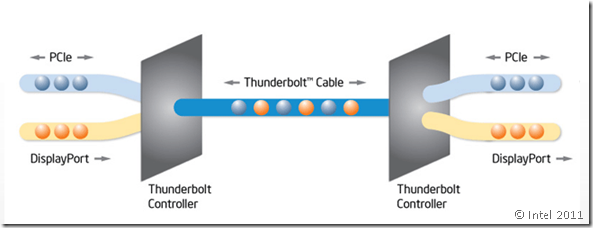Intel has finally realized a commercial package for it’s light peak initiative, in the form of Thunderbolt. Apple were the first to bring this to bear in the new MacBook Pro lineup announced last week, however Intel have been quick to claim that this will not be an Apple exclusive technology and will be available to other partners and OEMS.
Despite the name, and initial plans, Thunderbolt is currently based on an electrical medium, not an optical one, which shuns away from the initial concept of an optical interconnect for high demand peripherals and buses, but Intel have committed to continuing work on an optical option in the future, stating that results from testing on the electrical side were far better than expected, and keep both costs and complexity down for this initial offering.
Change of plans?
Light Peak was destined to be a transport medium, not a protocol itself, it wasn’t set to replace USB or FireWire, but the physical mediums used to connect these devices. The consensus initially was that USB may well be the protocol of choice, but Intel have opted for a combination of Display port and PCI Express thus far.
This diagram from Intel shows a simplified version of how the technology works
As you can see, the Thunderbolt controllers at both ends (say, a monitor and a MacBook Pro) combine the signals from the two sources to cross a single cable, this allows the single mini display port on a MacBook Pro to provide the video signal to the monitor, as well as other peripheral connectivity. Like USB, the ability to daisy chain these connections is built in, for example, allowing a monitor to have Thunderbolt ports for other connections back to the MacBook Pro
Utilizing PCIe in this manner provides some interesting possibilities, by extending the bus to remote devices there is potential to connect numerous other controllers directly to the PCIe bus on the remote device, and connect seamlessly to the host system via the single Thunderbolt cable. For instance, rather than just finding USB ports on a monitor, a manufacturer could build an entire controller into the monitor for USB, FireWire, eSATA and have those controllers connect to the PCIe bus of the host system via Thunderbolt. This opens up some interesting possibilities in deployment options for vendors, as well as streamlining the way we connect peripherals to the host system (I for one have very few spare ports on the back of my systems at present, a way to streamline more effectively than multiple USB hubs is always appreciated!
The downside to this is obviously the extension of the PCIe bus outside of the host system, which has already caused some parties to claim security concerns, although this is no different than with existing bus extension technologies that operate at such low hardware layers, such as Express Card and FireWire.
Lots of bits, not a lot of cable
The most staggering achievement of the new technology is the bandwidth it brings to consumer devices, each Thunderbolt port provides two full duplex, bi-directional 10Gbps channels totaling 40Gbps, although only adds display port 1.1a support on top of this, rather than the newer 1.2 standard, even so, this amounts to a combined total of almost 60Gbps of bandwidth, from that single port!
The potential for this technology is quite astounding, and with bandwidth like that there are a myriad of new ways of approaching connectivity that could be imagined, however the standard at present is an Intel only offering, requiring the purchase of controllers from Intel, this itself could hinder the protocols adoption by third parties, especially ones loyal to competitors such as AMD, which would ultimately undermine the growth of the standard.
Look out for compatible devices from Promise and Lacie already announced, as well as other vendors in the near future

